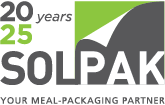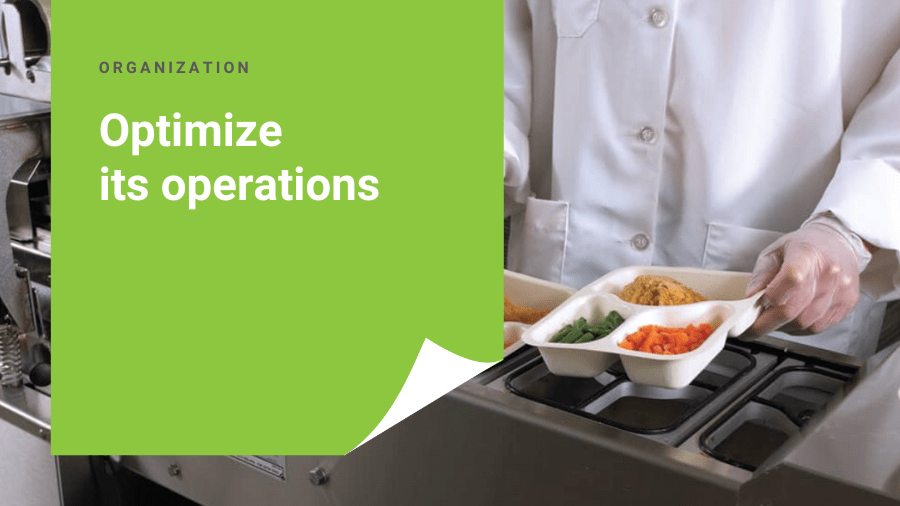In an industry where speed and efficiency are key to meeting consumer expectations, companies supplying ready-to-serve meals must continually improve their packaging methods. Whether in hospitals, schools, caterers, Meals-on-Wheels or prisons, the integration of heat sealers, whether manual or automated, can greatly improve productivity and quality of operations. This article explores the advantages of heat sealers over traditional methods, such as the use of lids, as well as the positive impact of Just-in-Time (JIT) delivery for better inventory management.
In the current context of labour shortages, the adoption of heatsealers is becoming a strategic solution for companies seeking to optimize their packaging processes. By automating a number of repetitive tasks, heat-sealers make up for staff shortages while maintaining high productivity and quality. This also frees up employees for more complex, higher value-added tasks, reducing pressure on teams and contributing to better human resources management.
In many companies, meals are still being packaged manually, with lids being secured by hand. This method, though simple, has a number of disadvantages compared to automated or even manual heat-sealing machines. In fact, hermetically sealing a tray with a heat sealer provides better protection against contaminants, and ensures that the contents remain intact during transport.
Time-saving efficiency
Heatsealers offer unrivalled speed compared to manual lidding. Whereas manual application can be time-consuming and error-prone, a heat sealer seals trays in seconds, increasing production output. This efficiency is crucial for establishments handling large volumes of meals on a daily basis.
Consistency and reliability
One of the main advantages of heatsealers, particularly automated models, is the consistency of the seal. Unlike manual lids, which can sometimes be ill-fitting or loose, heatsealers ensure a consistent, secure seal every time, which is essential for maintaining food freshness and safety, especially on long journeys.
Reduced human error
Manual operations are naturally prone to errors, such as misplaced or incorrectly secured lids. Heat-sealers, on the other hand, significantly reduce these risks by providing a uniform seal and minimizing the human intervention required. This ensures that every meal is properly sealed, reducing the risk of cross-contamination and other hygiene-related problems.
Improved resource management
With an automated thermosealing machine, human resources can be redirected to more strategic, less repetitive tasks, improving overall company productivity. For companies handling large volumes, this translates into a more efficient use of time and a better allocation of resources, compared to manual processes where each meal requires individual attention to securing the lids.
Advantages of JIT delivery for better optimization of storage space
Reduced warehousing costs
One of the main concerns of companies supplying ready-to-serve meals is the management of packaging materials. By adopting a Just-in-Time (JIT) approach to packaging delivery, you can minimize warehousing costs. By receiving only the quantities needed at short notice, you avoid high storage costs and reduce the risk of stock deterioration.
Maximize workspace
With JIT delivery, space previously reserved for storage can be reallocated to more productive activities, such as expanding output or improving production lines. This is particularly beneficial in environments where space is at a premium, such as hospital kitchens or school cafeterias, where every square meter needs to be optimally utilized.
Reducing losses and managing waste
JIT management also helps to reduce waste. By keeping stock levels to a minimum, you reduce the risk of packaging materials expiring or becoming damaged before they can be used. This is particularly relevant for companies using innovative packaging materials, such as biodegradable packaging, which often have a shorter lifespan.
Flexibility and adaptation to demand
Finally, JIT delivery offers greater flexibility to adapt to fluctuations in demand. If the volume of meals to be produced increases or decreases, you can adjust your packaging orders accordingly, avoiding overstocking or shortages. This agility is an asset for caterers and institutional food services who regularly have to respond to fluctuating demands.
Integrating heat sealers, whether manual or automated, into your food packaging operations, coupled with efficient inventory management via Just-in-Time delivery, can transform the way you work. By adopting these technologies and strategies, your company not only improves efficiency, but also enhances food safety and optimizes the use of resources.
To explore how our packaging solutions can meet the specific needs of your business, please contact us today. Our experts are ready to help you choose the equipment and strategies that will maximize your operations.

